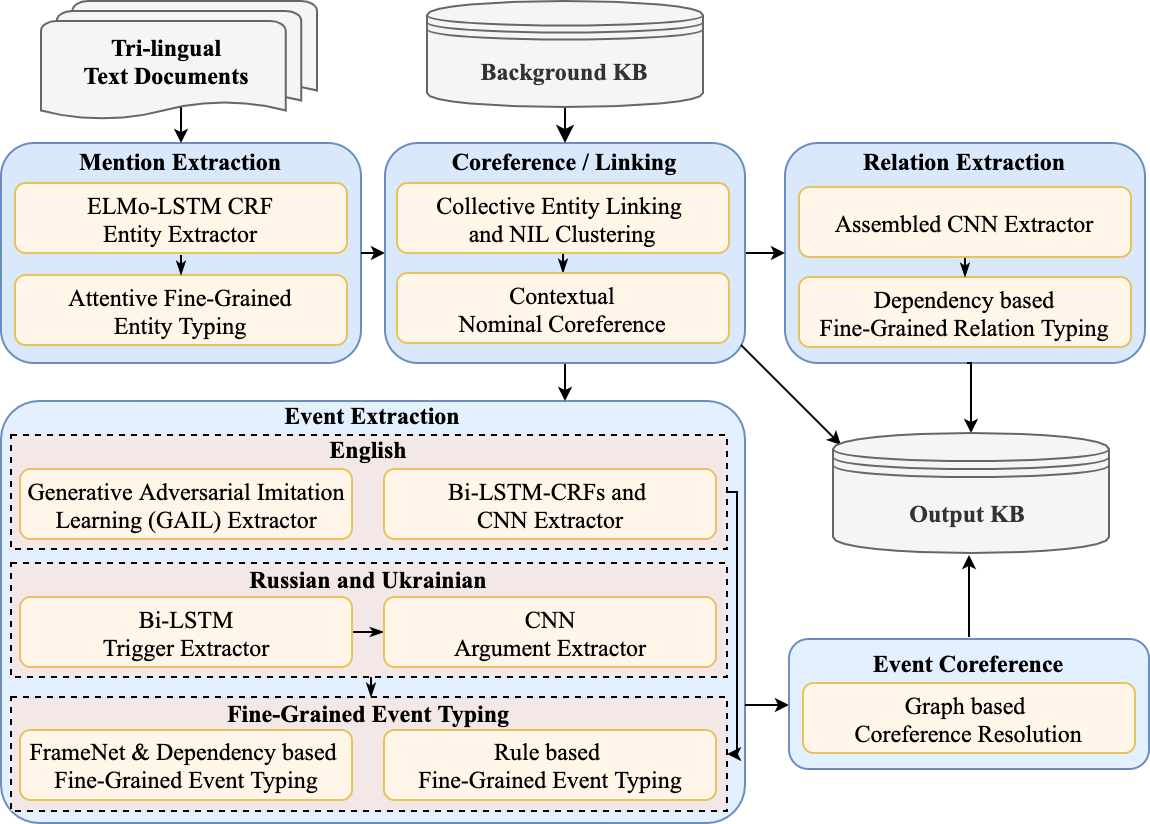One single script to run text information extraction, including fine-grained entity extraction, relation extraction and event extraction.
Docker (Please do not set up UIUC IE Pipeline in a NAS, as the EDL needs MongoDB, which may lead to permission issues in a NAS.)
- Prepare a data directory
datacontaining sub-directoriesrsdandltf. Thersdsub-directory contains RSD (Raw Source Data, ending with*.rsd.txt), andltfsub-directory has LTF (Logical Text Format, ending with*.ltf.xml) files.- If you have RSD files, please use the
aida_utilities/rsd2ltf.pyto generate the LTF files.
docker run --rm -v ${ltf_dir}:${ltf_dir} -v ${rsd_dir}:${rsd_dir} -i limanling/uiuc_ie_m36 /opt/conda/envs/py36/bin/python /aida_utilities/rsd2ltf.py --seg_option nltk+linebreak --tok_option nltk_wordpunct --extension .rsd.txt ${rsd_dir} ${ltf_dir}
- If you have LTF files, please use the AIDA ltf2rsd tool (
LDC2018E62_AIDA_Month_9_Pilot_Eval_Corpus_V1.0/tools/ltf2txt/ltf2rsd.perl) to generate the RSD files.
- If you have RSD files, please use the
- Start services
sh set_up_m36.sh- Run the scripts. Note that the file paths are absolute paths.
sh pipeline_full_en.sh ${data_root} ${GPU_id}For example,
sh pipeline_full_en.sh ${PWD}/data/testdata_dryrun 0If there is no gpu, please only set the data_root parameter:
sh pipeline_full_en.sh ${data_root}sh pipeline_sample_m36.sh ${data_root_ldc} ${kb_data_dir} ${output_dir} ${parent_child_tab} ${en_asr_path} ${en_ocr_path} ${ru_ocr_path} ${thread_num}where parent_child_tab is the file meta data in docs of LDC corpus. kb_data_dir is the data directory of a LDC released KB, such as ${PWD}/data/LDC2020E27_AIDA_Phase_2_Practice_Topics_Reference_Knowledge_Base_V1.1/data. For example,
sh pipeline_sample_m36.sh ${PWD}/data/LDC2020E29 ${PWD}/data/LDC2020E27_AIDA_Phase_2_Practice_Topics_Reference_Knowledge_Base_V1.1/data ${PWD}/output/output_dryrun_E29_test ${PWD}/data/LDC2020E11_AIDA_Phase_2_Practice_Topic_Source_Data_V1.0/docs/parent_children.tab ${PWD}/output/output_dryrun_E11_asr_aln ${PWD}/data/video.ocr/en.cleaned.csv ${PWD}/data/video.ocr/ru.cleaned.csv 20If there is no ASR and OCR files, please use None as input, e.g.,
sh pipeline_sample_m36.sh ${PWD}/data/LDC2020E29 ${PWD}/data/LDC2020E27_AIDA_Phase_2_Practice_Topics_Reference_Knowledge_Base_V1.1/data ${PWD}/output/output_dryrun_E29_test ${PWD}/data/LDC2020E11_AIDA_Phase_2_Practice_Topic_Source_Data_V1.0/docs/parent_children.tab None None None 20Reduced Version disables the functions that will take long runningtime, including the functions of entity filler extraction (time, value, title, etc), part of fine-grained event extraction, etc.
sh pipeline_reduced.sh ${data_root_ltf} ${data_root_rsd} ${output_dir}For example,
sh pipeline_reduced.sh ${PWD}/data/testdata_dryrun/ltf ${PWD}/data/testdata_dryrun/rsd ${PWD}/output/output_reduced_dryrunPlease prepare the input data file structure:
- CU_toolbox
- data
|------rsd
|------ltf
|------vision
|------------data/jpg/jpg
|------------data/video_shot_boundaries/representative_frames
|------------docs/video_data.msb
|------------docs/masterShotBoundary.msb
|------------docs/parent_children.tab
|------cu_objdet_results
|------cu_grounding_results
|------cu_grounding_matching_features
|------cu_grounding_dict_files
where docs/video_data.msb and docs/masterShotBoundary.msb are empty files and data/video_shot_boundaries/representative_frames is an empty directory. docs/parent_children.tab contains meta data of images and text documents in the format of
catalog_id version parent_uid child_uid url child_asset_type topic lang_id lang_manual rel_pos wrapped_md5 unwrapped_md5 download_date content_date status_in_corpus
separated by TAB.
If one image (e.g., image_1.jpg) and one text document (e.g., text_1.ltf.xml) belongs to the same news article (e.g., doc_1), then it should be formatted as:
gaia v1 doc_1 image_1 0 .jpg 0 0 0 0 0 0 0 0 0
gaia v1 doc_1 text_1 0 .ltf.xml 0 0 0 0 0 0 0 0 0
Please avoid . in the file names and use JPG as image suffix.
The sample code of preparation is in uiuc_ie_pipeline_fine_grained/multimedia/sample_data_preparation.py.
Please find the sample data and result in sample_data. The CU_toolbox can be downloaded in CU_toolbox.
Please run uiuc_ie_pipeline_fine_grained/multimedia/multimedia.sh to extract objects from images, and perform cross-media coreference.
The object results are saved in cu_objdet_results/aida_output_34.pkl(pickle format), and grounding results are saved in cu_grounding_results(pickle format) and cu_graph_merging_ttl (RDF format). Please find the grounding result visualization code in uiuc_ie_pipeline_fine_grained/multimedia/visualize_ttl_grounding.py using the RDF format output.
Please find source code in https://github.com/limanling/uiuc_ie_pipeline_finegrained_source_code.
GAIA system is licensed under the GNU General Public License v3 or later.
@inproceedings{li2020gaia,
title={GAIA: A Fine-grained Multimedia Knowledge Extraction System},
author={Li, Manling and Zareian, Alireza and Lin, Ying and Pan, Xiaoman and Whitehead, Spencer and Chen, Brian and Wu, Bo and Ji, Heng and Chang, Shih-Fu and Voss, Clare and others},
booktitle={Proceedings of the 58th Annual Meeting of the Association for Computational Linguistics: System Demonstrations},
pages={77--86},
year={2020}
}
